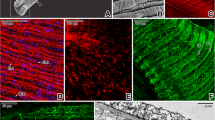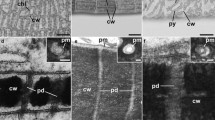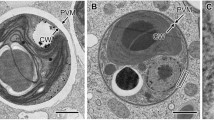Summary
Pit connections (PCs) develop between the parasitic red algaHolmsella and its hostGracilaria. Only parasite cells initiate the formation of host-parasite pit connections. The parasite produces a small connecting cell (termed the “conjunctor cell”) which moves through the cell wall to fuse with either an adjacent host or parasite cell. The parasite secondary PC, which forms between the conjunctor cell and the parasite cell, is structurally different from a parasite primary PC, and has the distinct structure of a host-parasite PC. Only if the conjunctor cell fuses with another parasite cell will the former parasite-conjunctor cell PC be altered to a typical parasite-parasite PC. If the conjunctor cell fuses with an adjacent host cell the PC continues to develop as host-parasite. Occasionally a conjunctor cell fails to fuse with an adjacent cell (whether host or parasite), and the conjunctor cell and PC eventually breakdown in the cell wall. The parasite overcomes several barriers in order to infect the host, including the formation of host-parasite PCs which appear to be a necessary component of the parasiticHolmsella-Gracilaria association.
Similar content being viewed by others
References
Clarke, A. E., Gleeson, P. A., 1981: The molecular basis of recognition and response in the pollen-stigma interaction. In: Recent Advances in Phytochemistry. Plant Cell Recognition (Loewus, F., ed.). New York: Appleton-Century-Crofts (in press).
Demoulin, V., 1974: The origin of Ascomycetes and Basidiomycetes; the case for a red algal ancestry. Bot. Rev.40, 315–345.
Evans, L. V., Callow, J. A., Callow, M. E., 1978: Parasitic red algae: an appraisal. In: The Systematics Association Special Volume No. 10: Modern Approaches to the Taxonomy of Red and Brown Algae (Irvine, D. E. G., Price, J. H., eds.), pp. 87–110. London: Academic Press.
Goff, L. J., 1976: The biology ofHarveyella mirabilis (Crytonemiales; Rhodophyceae). V. Host responses to parasite infection. J. Phycol.12, 313–328.
—, 1979: The biology ofHarveyella mirabilis (Cryptonemiales, Rhodophyceae). VII. Structure and proposed function of hostpenetrating cells. J. Phycol.15, 87–100.
Kugrens, P., West, J. A., 1973: The ultrastructure of an alloparasitic red algaChloreocolax polysiphoniae. Phycologia12, 175–186.
Nonomura, A. M., West, J. A., 1980: Ultrastructure of the parasiteJanczewskia morimotai and its hostLaurencia nipponica (Ceramiales, Rhodophyta). J. Ultrastruct. Res.73, 183–198.
Peyrière, M., 1977: Ultrastructure d'Harveyella mirabilis (Cryptonemiales, Rhodophycee) parasite deRhodomela confervoides (Ceramiale, Rhodophycee): origine des synapses secondaires entire cellules de l'hote et du parasite et entre cellules du parasite. C. R. Acad. Sci. Ser. D285, 965–968.
Quirk, H. M., Wetherbee, R., 1980: Structural studies on the host parasite association between the red algaeGracilaria andHolmsella. Micron11, 511–512.
Waaland, S. D., 1975: Evidence for a species-specific cell fusion hormone in red algae. Protoplasma86, 253–261.
Wetherbee, R., Quirk, H. M., 1982: The fine structure and cytology of the association between the parasitic red alga,Holmsella australis and its red algal host,Gracilaria furcellata. Protoplasma110, 153–165.
—,Wynne, M. J., 1973: The fine structure of the nucleus and nuclear associations of developing carposporangia inPolysiphonia novaeangliae (Rhodophyta). J. Phycol.9, 402–407.
Author information
Authors and Affiliations
Rights and permissions
About this article
Cite this article
Wetherbee, R., Quirk, H.M. The fine structure of secondary pit connection formation between the red algal alloparasiteHolmsella australis and its red algal hostGracilaria furcellata . Protoplasma 110, 166–176 (1982). https://doi.org/10.1007/BF01283319
Received:
Accepted:
Issue Date:
DOI: https://doi.org/10.1007/BF01283319




